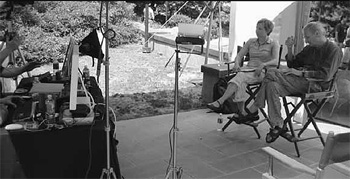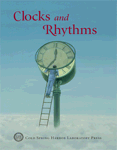|
LXXII: Clocks and Rhythms 2007 |
|
|

|
Symposium Interviews: S. Gary, M. Raff SYMPOSIUM SYNOPSIS LIST OF PARTICIPANTS CONTENTS OF SYMPOSIUM VOLUME PHOTOGRAPHS PUBLISHED VOLUME  |
Clocks and Rhythms
May 28 - June 2, 2007
Symposium Synopsis
Meeting Organized by Bruce Stillman, David Stewart, and Terri Grodzicker
The history of research into circadian rhythms can be traced back to the French astronomer Jean Jacques Ortous de Mairan, who conducted experiments with plants grown in the dark in the early 1700s. His observations started a slow march joined by luminaries such as Carolus Linnaeus and Charles Darwin interested in whether and how animal and plants measured time. The descriptive era of circadian biology continued into the latter half of the 20th century and was well summarized by the last Symposium held on the topic in 1960, in which the opening address by Erwin Bunning concluded that "thus far, however, such facts have not enabled us to draw far-reaching conclusions about the nature of the [biological] clock."
As with so many other disciplines in biology, the descriptive era has been revolutionized by the molecular era. Since the discovery and cloning of the first clock gene, period, more than 20 years ago, tremendous progress has been made about the nature of the clock and how it functions in a wide variety of different plants and animals. Research previously limited to describing "the hands of the clock" has been enormously successful in recent years in describing the inner anatomy and mechanism of the clock in individual cells and in the whole organism.
Many in the chronobiology community are now, more than ever, attempting to place the molecular and cellular details of the oscillatory machinery in the broader context of cellular physiology—for example, the cell cycle—or organismal behaviors—for example, sleep and circadian behavior, and how these may in turn be affected by environment and/or disease. It is noteworthy that Christoph Wilhelm Hufeland wrote in his 1796 treatise The Art of Prolonging Life, "The period of twenty-four hours formed by the regular revolution of our Earth...is apparent in all diseases...it is, as it were, the unit of our natural chronology."
Our decision to focus the 72nd Symposium on circadian and related rhythms reflects the tremendous advances that molecular and cellular approaches have yielded thus far, a decision taken in part thanks to an open letter from 18 prominent scientists in the field. The Symposium was arranged to cover a range of themes associated with biological clocks and rhythms, ranging in scale from the molecular to the whole organism, and addressed how aberrant function of the clock may have a causative role in diverse human diseases and conditions.
The Symposium provided a unique synthesis of the exciting progress being made in the field of chronobiology not only for the Symposia attendees, but also for a wider global audience via interviews freely available on the World Wide Web and, we anticipate, for readers of these Proceedings.
In organizing this Symposium, we relied on the assistance of Steve Kay, Steve McKnight, and Ueli Schibler, in particular, for suggestions for speakers. We also wish to thank the first evening speakers Joe Takahashi, Louis Ptá˘cek, Amita Sehgal, and Ron Evans for providing an overview of the areas to be covered. This year's Reginald Harris Lecture was delivered by Martin Raff on intracellular timers in oligodendrocyte precursor cells. We particularly wish to thank Michael Menaker—one of three participants along with Patricia DeCoursey and "Woody" Hastings, who attended both 1960 and 2007 Symposia—for delivering a masterful and eloquent summary of the current state of the field, and to Charles Czeisler who enlightened a mixed audience of scientists, lay friends, and neighbors with his Dorcas Cummings lecture on "Work Hours, Sleep, and Safety: Physician Heal Thyself."
This Symposium was attended by 316 scientists from more than 20 countries, and the program included an opening introductory workshop, 72 oral presentations, and 142 poster presentations. Essential funds to run this meeting were obtained from the National Institute of Neurological Disorders and Stroke, a branch of the National Institutes of Health. In addition, financial help from the corporate benefactors, sponsors, affiliates, and contributors of our meetings program is essential for these Symposia to remain a success and we aremost grateful for their continued support.
We wish to thank Val Pakaluk and Mary Smith in the Meetings and Courses Program office for their efficient help in organizing the Symposium. Joan Ebert and Rena Steuer in the Cold Spring Harbor Laboratory Press, headed by John Inglis, ensured that this volume would be produced. We thank them for their dedication to producing high-quality publications.
Bruce Stillman
David Stewart
Terri Grodzicker
January 2007
Search images: